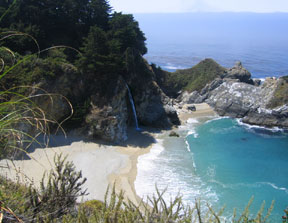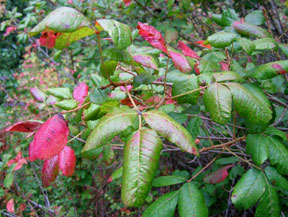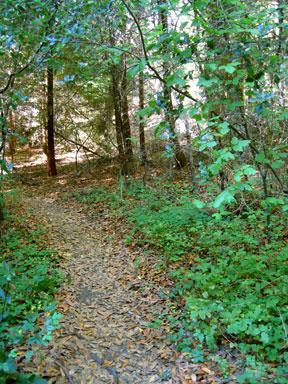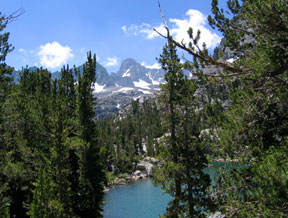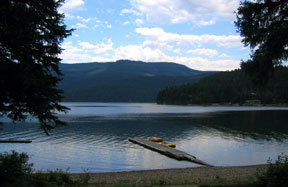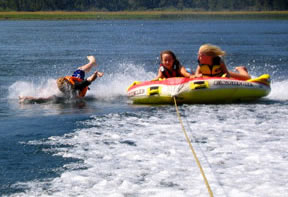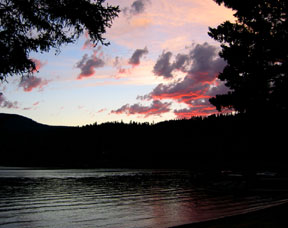| |
A Resource by Mark D. Roberts |
|
Summer Vacation 2005
by Rev. Dr. Mark D. Roberts
Copyright © 2005 by Mark D. Roberts
Note: You may download this resource at no cost, for personal use or for use in a Christian ministry, as long as you are not publishing it for sale. All I ask is that you give credit where credit is due. For all other uses, please contact me at mark@markdroberts.com . Thank you.
It's Always Something 
Part 1 of series Summer Vacation 2005 
Posted for Wednesday, August 17, 2005
| If you've been reading my blog for a year, you may recall that last year when I returned from my summer vacation I put up a bunch of posts inspired by where I'd been and what I'd done. Last year I did one series called European Reflections after a trip to Europe and another series called American Reflections, following a trip to Yellowstone, Grand Teton, and Zion national parks. This year my series is less elegantly named Summer Vacation 2005. I apologize for any false hopes this might give to Chevy Chase fans. |
"Well, Jane, it just goes to show ya, it's always something. If it's not one thing, it's another. . . ." So proclaimed Rosanne Rosannadanna, Gilda Radner's classic Saturday Night Live character. Usually Rosanne's insights had to do with some Catch-22 situation, like, "If you don't die from being overweight, you'll die from the stuff they put in diet soda."
I've adopted Rosanne's slogan for my camping experiences, though I expect what I'm about to describe is true, not just for my own camping trips, but for everybody else's too. When you go camping, it's always something.
Camping, you see, involves going into nature, and even in the well-manicured nature of national and state parks, it's always something. Inevitably there's always something that makes real nature just a little less than paradise – or sometimes a whole lot less. If the weather is perfect, the bugs will be terrible. No bugs, then you can expect a bear to steal your food. No bear? Then it'll be scavenging raccoons. No critters? Then we're back to bad weather. |
|
| |
"Well, Jane, it just goes to show ya, it's always something."
|
No matter how close you get to the perfect camping experience, there's always something to remind you that nature is still in charge. As my brother-in-law Mike always reminds us, "That's how it is with nature. You just can't control it." And he's right.
Of course I approach camping with the intention of mastering nature. My goal is to enjoy nature with perfect weather, no critters, no bugs, and even a decent night's sleep. That's a pretty unrealistic camping philosophy, I'll admit. But it is mine, at least at the beginning of a trip.
There have been times when I've been able to get close to my idyllic goal. For example, month ago my family and I camped in Big Sur, California (in the middle of the state on the coast, south of Monterey). I use the verb "camped" generously, because we slept in a trailer, not in a tent. Part of me thinks that it's cheating if I sleep more than a foot off the ground when I'm camping. But the rest of me thinks a good night's sleep is a great idea, so I'm willing to cheat.
Big Sur is a great place to camp: neither too hot nor too cold; almost no rain in the summer; no mosquitoes (!); no yellow jackets; no bears; no other obnoxious critters; and miles of beautiful scenery, including redwood forests and the stunning California coastline.
Yet, remember my camping slogan, it's always something. So if, in Big Sur, the weather's perfect, and there aren't any bugs or critters, and I can get a good night's sleep, what's left? Poison oak! More poison oak than I've ever seen before in me life. And as a long-term California resident, I've seen plenty. (According to some state park propaganda I read, it's the most common natural shrub in the state.) Wherever you walk in the Big Sur area, you must be continually on the lookout for poison oak.
If you're from other parts of the country, you may not be familiar with poison oak. It's a relative of poison ivy and poison sumac. Touch poison oak, or touch clothing that has brushed against it, or pet a dog that has run through it, and chances are that you'll end up with an oozing rash that itches worse than the worst chicken pox. A few lucky souls are immune to poison oak's venomous oil, but most of us are its potential victims.
My family and I did some excellent hikes while we were in Big Sur. This, of course, brought out my obsession to beat nature at its own game. So I became obsessively vigilant about avoiding touching poison oak. This is harder than it sounds, because that pesky plant not only grows along the trails, often spilling over to touch your legs, but also it can climb up into trees and hang down over the trails – right at face level, just for sport. It's as if the poison oak demon were doing everything in his diabolical power to make sure innocent hikers end up with an irritating rash as a souvenir of their trip to Big Sur.
I think, to be honest, that I almost drove my family nuts with my repeated warnings about poison oak. When I was leading a hike, if I saw a sprig near the trail, I'd let everybody know. Of course this meant I was shouting "poison oak" every few yards, which can get old, I'll admit. But my efforts paid off, as none of us ended up with a rash that ruined the rest of our vacation. |
|
|
McWay Falls in Julie Pfeiffer Burns State Park, Big Sur, California
|
|
A close-up of poison oak. The leaves turn red in the late summer and fall.
|
|
A trail in Pfeiffer Big Sur State Park, with poison oak on either side. Plus, most of what looks like leaves of an oak tree at eye level is in fact poison oak. Let the hiker beware!
|
The sticklers among my readers will no doubt observe that poison oak could just as easily work its dark magic on visitors who stay in Big Sur's cozy bed and breakfast inns. This isn't just a camping issue. I agree. But campers tend to spend more time out in nature, and in Big Sur this means more potential exposure to poison oak. In the wonderful Pfeiffer Big Sur State Park, many of the paths from campsites to the bathrooms are lined with glorious poison oak. Presumably bed and breakfast patrons don't have to worry about this when they make a trip to the loo in the middle of the night.
So, like Rosanne Rosannadanna says, when you're camping, it's always something. If this doesn't appeal to you, then don't camp. But if you can cope with the inevitable "something," then camping offers a marvelous break from the multiple "somethings" of ordinary, civilized life.
Living Among the Giants 
Part 2 of series Summer Vacation 2005 
Posted for Thursday, August 18, 2005
Many Americans think California lives on the far side of sanity, while many Californians think they live in the greatest of the fifty states. I could probably make arguments for both sides, to tell you the truth, but there are some things about California that are unquestionably both wonderful and unique within the United States. One of these things is the prevalence of redwood trees.
There are two species of redwood trees in the United States, the Coast Redwood (Sequoia sempervirens) and the Giant Sequoia (Sequoiadendron giganteum). Almost all of both species exist only in California, though southern Oregon has some of the Coast Redwoods. The majority of this species can be found along the coast (where else?) of California, while all of the Giant Sequoia trees live in the Sierra Nevada mountains of the state, in elevations around 5,000 feet.
The redwoods are truly gorgeous trees and spectacular for their size. Some of the coastal redwoods are more than 30o feet high. The Sierra redwoods, though not quite as tall, are larger in mass. The General Sherman Tree in Sequoia National Park is 101 feet in circumference, 272 feet tall, and weighs over 6,000 tons.
If you have never seen the California redwoods, you've missed one of life's marvels. In fact, when the Giant Sequoia trees were first being discovered by white people, the discoverers were generally thought to be lying. At the 1893 World's Fair in Chicago the lower portion of a genuine Giant Sequoia tree was put on display, but the whole thing was widely regarded as a hoax.
Three years ago my family and I camped at Calaveras Big Trees State Park in the Sierra Nevada mountains. Because the root system of the Giant Sequoia is relatively fragile, you can't actually camp among the big trees. Not so with the Coast Redwoods, however. In public parks and private campgrounds you can actually live among the giants. This year we camped at a private campground in Big Sur, the Fernwood Resort, and found ourselves right in the middle of a small but towering redwood grove. In the mornings I walked through the contiguous state park, enjoying the majesty and mystery of the redwoods there.
If you've never seen the California redwoods, you ought to put it on your list of "must-dos." You can see the Giant Sequoias at either Yosemite or Sequoia/King's Canyon national parks. I prefer to avoid the crowds at Yosemite, though if you've never visited Yosemite Valley, this is another "must-do." You can nail Half Dome and the Giant Sequoias in one day. Your options for viewing the Coast Redwoods are many if you're in the greater San Francisco area. I'm partial to Big Sur, as you know, and also to Big Basin State Park in the mountains above Santa Cruz.
|
|
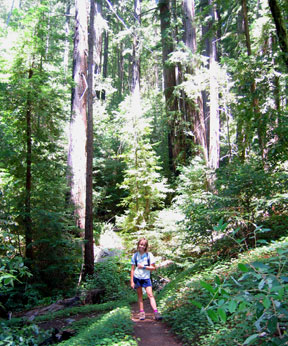 |
My daughter hiking in the Big Sur redwoods
|
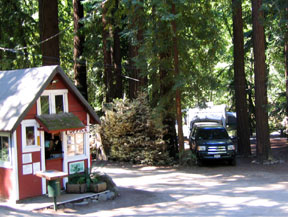 |
Our campsite (trailer behind the green truck) in the midst of the redwoods
|
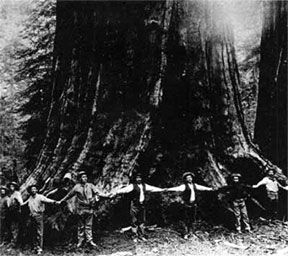 |
The Giant Sequoia to be displayed at the 1893 Chicago World's Fair, just before it was cut down by these men. Even the picture didn't convince the skeptics.
|
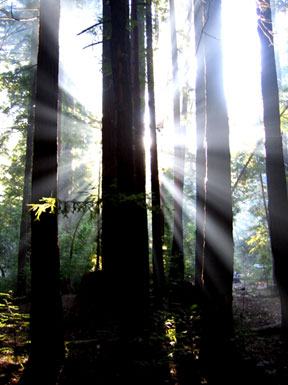 |
Sunrise in the morning mist of Pfeiffer Big Sur State Park |
A Haunted Cabin? 
Part 3 of series Summer Vacation 2005 
Posted for Friday, August 19, 2005
If ever you find yourself hiking up the North Fork of Big Pine Creek on the eastern side of California's Sierra Nevada mountains, be prepared for a surprise. (Of course if you read this post, it won't really be a surprise anymore. Sorry.)
This hike begins at 7700 feet, relatively low for an eastern Sierra trailhead. But quickly you find yourself climbing a steep series of switchbacks alongside roaring Big Pine Creek. Emerging from the lush creekside flora after about a half mile, you meander in the direction of the creek on what was once a road of sorts (perhaps for mining). Now it's a trail for foot travel only, human and equestrian. After about a mile and a half you climb steeply along a waterfall and then enter a sylvan wonderland aptly named Cienega Mirth. By now you are in the John Muir Wilderness, a stunningly beautiful but relatively inaccessible section of the Inyo National Forest.
Three miles from the trailhead, at 9200 feet, you see an unusual site: a stone cabin on the side of the creek. Buildings of any kind are rare in wilderness areas. And, given the remote location of this cabin, it's hard to imagine how it was built in the first place. A simple sign identifies the cabin as a wilderness ranger cabin. Yet it seems both abandoned, as if rangers never use it, and in surprisingly good condition, as if somebody is taking care of it. "How did this cabin get here?" you might wonder. "And why is it still here?" given the fact that most structures like this in wilderness areas have been demolished, either by weather, or by human effort, or, as is usually the case, both.
Ordinarily my interest in this cabin would disappear by the time I had returned to my car. But I discovered something about this cabin that makes it even more interesting and mysterious than I first had thought. It was built by the actor Lon Chaney, who is best known for his cinematic portrayal of various scary monsters, including The Phantom of the Opera and The Hunchback of Notre Dame. Would you want to camp near the Chaney cabin at night? I rather doubt it, given the possibility of there being monsters in the forest. |
|
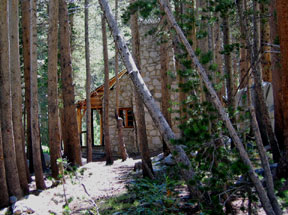 |
Above: the cabin as it is first seen from the trail.
Below: the porch of the cabin as seen from Big Pine Creek.
|
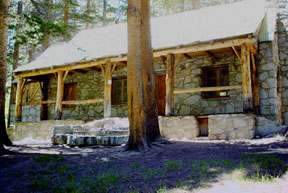 |
I should mention that the Lon Chaney who built the cabin is Lon Chaney Senior, the father of Lon Chaney Junior, who was also a movie star with a particular expertise in the area of monsters. The younger Chaney is perhaps best known for his chilling portrayal of the Wolfman, though he did a scary Dracula as well as lots of other monsters. Nevertheless, he's not the one who built the cabin, nor is there evidence that he spent time there. (A curious bit of trivia: Lon Jr. attended Los Feliz Elementary School in Los Angeles. That's where my grandmother went to school. She was a year older than Lon Jr., who went by his given name, Creighton. They were both active in school drama. I wonder if my grandmother knew Lon Jr., or even his father? I wish she were still around so I could ask her.)
While I'm clearing up misconceptions, I should also mention that the Chaney cabin is not in Muir Woods, as some people have mistakenly claimed. Muir Woods National Monument is near San Francisco, a couple of hundred miles from the John Muir Wilderness. (Ironically, given my last post, Muir Woods preserves some of the oldest and biggest of the Coast Redwoods.)
Perhaps one of the oddest and saddest parts of the Chaney cabin saga is that Lon Sr. died only a few months after finishing the building. He had bronchial cancer, which became quite severe while he was at the cabin in July 1930. He died in August of that year. |
|
 |
Above: the elder Chaney as the Phantom
Below: the younger Chaney as the Wolfman. Like father, like son.
|
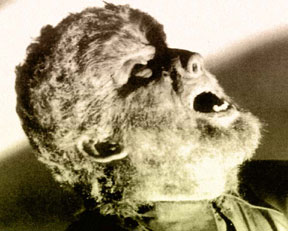 |
Two years later the cabin was sold to someone else. In time ownership passed to the federal government, who at first planned to destroy the cabin. But there was no way to take down such a solid building without dynamite, which would have devastated the whole area. In time the Forest Service decided that the cabin's historic value warranted its preservation. Currently the building is under consideration for inclusion on the National Register of Historic Places.
The cabin's rich history goes beyond it's first owner. It was designed by Paul Revere Williams, a famous architect from the early 20th century. What makes Williams especially notable is the fact that he was one of the first highly regarded African American architects. Though he designed more than 2,000 homes, Williams apparently designed only one cabin.
Today hikers enjoy a rest on the cabin's porch. Some swim in the creek or fish. The location can't be beat. And if you're willing to hike a couple miles further upstream, you'll come to some of the prettiest country in the world. No joke. No exaggeration. It's too bad that Lon Chaney, a lover of the High Sierra, didn't live long enough to enjoy his cabin for many years. |
|
| |
Fifth Lake, not too far from the Chaney cabin |
Given the cabin's odd history, you'd expect to find rumors of its being haunted. But I haven't heard a peep about such things. Whether Lon Chaney's ghost might haunt the place today I'm in no position to know. If I were a ghost, however, I wouldn't mind hanging out along the North Fork of Big Pine Creek. You can't do much better than this, no matter what your mortal condition.
Notes:
Some of my information for this article was retrieved from an article in the Los Angeles Times, which you can download for a price. The National Forest Service also has a webpage devoted to the cabin.
A Real Leap of Faith, Section A 
Part 4 of series Summer Vacation 2005 
Posted for Sunday, August 21, 2005
The Danish philosopher Søren Kierkegaard coined the now-familiar phrase, "a leap of faith." For him, true Christianity involved a leap of faith, which is to say, a leap beyond reason, a jump that could not be fully defended by reason. The faith element, if you will, involved hurling oneself out into that which could not be understood. It was a leap into the absurd, which meant for Kierkegaard that that it always came with fear and trembling.
Without a doubt, genuine Christianity involves a leap beyond that which we can completely grasp. If I wait until I've figured everything out before trusting Jesus, I'll wait forever. At some point I must survey that which is before me and go an extra step, a step that I cannot justify by logic alone.
From a theological point of view, this is a response to God's grace and to the work of the Holy Spirit. Faith isn't something I work up all by myself. It is my respone to God's work within me, a miracle that springs out beyond what I can comprehend or control.
But, I would argue, Christian faith isn't contrary to reason, though it surely transcends it. I put my faith in Christ, not simply because I choose to, but because I have reason enough for this step of trust. What I read in the Bible satisfies my mind even as it touches my heart. The facts of gospel lead me to accept its truth, though they can't lead me all the way to genuine faith.
So, to be sure, Christianity requires a leap of faith, but not a senseless or defenseless leap. Rather, it is one based upon a reasonable assessment of the evidence even as it goes beyond that assessment. There is a risk, to be sure, in faith. It involves trusting that which I cannot fully know. It requires putting my faith in Jesus Christ, even though I cannot see Him, and even though there's so much about Him that I don't understand.
Christian faith is rather like an experience I had this summer while on vacation. My family and I visited some friends at Swan Lake, Montana (in the northwest corner of the state, near Kalispell). One of the hallowed Swan Lake traditions, I discovered to my chagrin, involves jumping off a cliff into the lake.
Now I do well with such things when the jump is around ten feet or less. But, since I'm somewhat afraid of heights, I don't enjoy jumping off of things that are much higher than ten feet, whether cliffs, or diving boards, or platforms, or you name it. The Swan Lake cliff, I learned, a leap from a rocky ledge 26 feet in the air. Not exactly my cup of tea.
I would have gladly passed on the cliff and watched others demonstrate their foolishness, but my children really, really, really wanted me to jump with them. Really! So I figured "What the heck? How bad can it be?"
Pretty darn bad, I discovered as I arrived at the top of the cliff. From the bottom 26 feet doesn't look like too much. But when you're looking down from that height, 26 feet looks more like 126, or even 1,026.
As I peered down to the water that seemed to be miles below me, I realized how much I did not want to jump. I remembered a time when I was about seven years old. I had gone to a pool that had a high dive. For a couple of hours I fretted about whether or not to take a plunge from the ten-foot-high board. Finally I got up all my nerve, and waited in line to go off the high dive. When it was my turn, I climbed the ladder, walked to the end of the board, and stared into the abyss. And then I stared some more. And then some more. After about 30 seconds the people in line began to encourage me. "Just jump," they yelled, "you'll be fine." After a minute their encouragements turned to complaining, "If you're not going to jump, just get off. We don't want to wait around all day." After another minute or so I slowly backed up and climbed down the ladder, deeply ashamed of my cowardice. I didn't try another high dive for another ten years. |
|
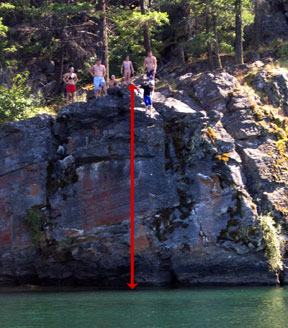 |
Top: A view of the Swan Lake Cliff. The arrow indicates the 26 feet of the jump. My son is the unfortunate jumper.
Bottom: What it looks like as you're beginning to plummet to the depths. No trick photography here. I was standing behind my son as he jumped.
|
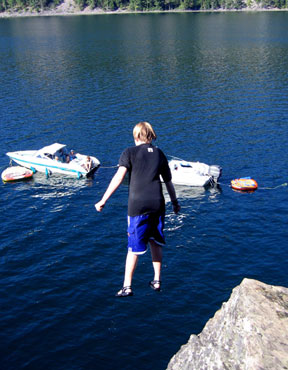 |
And so, four decades after my first debacle with jumping off a high perch into the water, or not jumping, to put things more truthfully, I looked down at Swan Lake and the ant-sized people gazing up at me, and, as Kierkegaard so rightly noted, I felt fear and trembling. Literally. My right leg was shaking, and the rest of my body wasn't far behind.
What did I do? You'll have to wait until tomorrow for the conclusion of this story.
A Real Leap of Faith, Section B 
Part 5 of series Summer Vacation 2005 
Posted for Monday, August 22, 2005
Yesterday I began this discussion of the leap of faith, referring to Kierkegaard and explaining ways in which Christianity requires a leap of faith. It's a leap that is based upon evidence, to be sure, but one that goes beyond what can be proved by reason.
I also explained yesterday how I got myself into a mess of trouble this summer at Swan Lake, Montana. When I left the story, I was peering down from a twenty-six foot cliff into the dark waters of the lake, feeling fear and trembling as I wondered whether or not to jump into the lake.
Gazing down to Swan Lake, far, far below me, I thought about what I knew to be true. The water was very deep where I was jumping, so there was no chance of injury from hitting submerged rocks. Hundreds of people had made this jump in the past without series injury, as far as I know. I didn't want to belly flop from 26 feet up, that's for sure, but even that wouldn't kill me. And if, for some reason, I did hurt myself when I hit the water, twisting an ankle, getting the wind knocked out of me, or pulling a shoulder muscle, there were plenty of good swimmers around to save me. So the facts stood clearly indicated that I wouldn't be seriously hurt if I were to jump. Now if I could only get my stomach to line up with the facts . . . .
As I felt both fear and trembling in those seconds on the edge of the cliff, if I went with my feelings, I would have turned back, no matter how embarrassed I would have been, and no matter how much I would have disappointed my children. But as I stood there, I considered the facts, and then considered them some more, and then I jumped. A real leap of faith!
Although I was in the air for only a couple of seconds, it seemed much longer than this. The water felt hard as I hit it, and then cold, and then comforting. I quickly surfaced, all in one piece, very happy that my ordeal was over. I had survived my plunge from the Swan Lake cliff!
Why did I jump? There are two reasons. The first, as I've explained, had to do with facts. I had every reason to believe that I would not hurt myself by jumping. Though I couldn't prove this completely, I knew that I had reason on my side.
But this doesn't explain why I bothered to jump in the first place. What motivated me to do what I otherwise would have avoided? Love. Love for my children, plain and simple. They wanted me to share in their excitement, and I wanted to share an experience with them. I wanted to join them in their world. As I gazed into the watery void below me, their love for me strengthened my resolve. And my love for them gave me an extra nudge. And so . . . I jumped.
Unlike my children, who gladly made several jumps, I had planned to do it only once. But, as fate may have it, the person taking the picture of my jump wasn't ready for me and only got the splash at the end. That was really fine with me, but not with my kids. They wanted a picture of their dad jumping off the Swan Lake cliff, a souvenir of our shared adventure. So I reluctantly climbed up and did it all over again. You might think that the second jump was easier. But you'd be wrong. I still feel the lead in my stomach when I remember what it was like to look down from that cliff. It did feel good, however, to hear my daughter say to me after it was all over: "You're great, Dad. You're the best dad ever." For that, well, I'd do it all over again. |
|
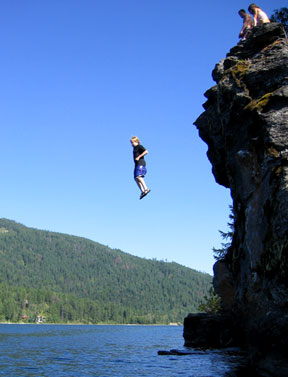 |
Above: Side view of my son in mid-air
Below: My daughter gets into the action too.
|
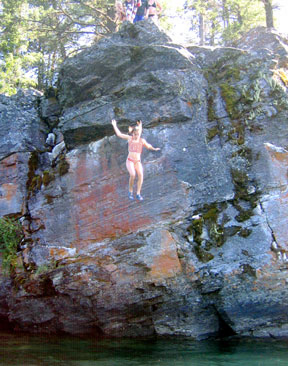 |
Below: My leap of faith.
|
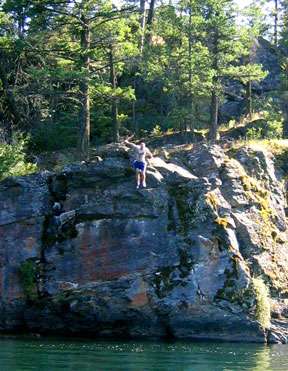 |
My jump from the cliff was like Christian faith because it was based on evidence. I knew the facts, and the facts worked in my favor. I wasn't leaping off any old Swan Lake cliff, but from a place that had been tested for decades and was found to be reliable. Moreover, my jump off the cliff was like Christian faith because it was infused with love: my kids' love for me as their dad and my love for them.
Yet, like Christian faith, in the end I had to jump. It was an act of will, not feeling. It was flinging myself out into what I didn't fully know, even though I had enough knowledge to warrant jumping. My leap was trusting on the basis of the truth, yet going beyond simple acknowledgement of the truth. I could have remained in the boat and said, "I believe that if I were to jump off that cliff I'd be fine." That would be intellectual assent, but not genuine faith. Jumping was something else. It was putting myself on the line. It was acting in light of what I believed to be true. It was leaving the safety of solid ground for the freedom of space. And it was motivated by love. In sum, it was a real leap of faith.
Lakeside Reflections 
Part 6 of series Summer Vacation 2005 
Posted for Sunday, August 28, 2005
| If you've been reading my blog for a while, you know that I often vary the menu on Sunday. Sometimes I take a break from blogging; at other times I put up something either fun or inspirational or both. Today's post is meant to be both. I'll get back to the Pope tomorrow. |
On my vacation this summer I spent a week at Swan Lake, Montana. An idyllic spot in the northwestern corner of the state, Swan lake is near the much larger Flathead Lake and the city of Kalispell. Because it's a bit off the beaten path – which describes most of Montana, actually – Swan lake is exceptionally peaceful. Plus, since it's not much of a fishing lake, it doesn't fill up with crowds of anglers in hi-tech bass boats. For much of the time and for most of the year, Swan Lake offers a refuge from the noise and busyness of ordinary existence.
One of my favorite things to do while at the lake was to get up early in the morning and spend time reading and praying on the deck of the cabin where my family and I were staying. For an hour or so I enjoyed almost complete stillness. The playful noises of people were yet to intrude into the quiet. And there weren't any boats on the water to disturb its mirror-like surface or to ruin my serene reverie. These were glorious moments of deep rest and relaxed prayer, times that truly restored my soul. |
|
| |
Swan Lake in the early morning
|
But each morning my temporary paradise would eventually be disturbed by the rumble of a gasoline motor. Usually it was a powerboat a few cabins down, beginning the day's work of towing water-skiers and wake-boarders. Occasionally it was the invasive roar of a jet ski, a device notorious for creating equal amounts of noise and fun. Unfortunately, only the rider gets the fun; everybody else gets the blaring noise.
As I sat on the deck, grieving the loss of my quiet time, I wondered why lake users don’t have an unwritten agreement to rev up their motors only when they're a couple of hundred yards offshore. By quietly moving away before cutting loose, they ensure that the noise levels on shore would be much more tolerable. This seems to be such an easy way to improve the quality of life for all lake visitors. But, then again, maybe I just don't get the joy of gunning a jet ski engine in the faces of folks on shore, showing off my mechanized prowess.
| I don't mean to imply that I'm against the use of motorized contrivances on a lake, however. Though my personal preference is for kayaking, I'm perfectly happy to let folks enjoy the thrills of a powerboat. My own children loved tubing on Swan Lake: being dragged behind a speedboat on an oversized inner tube with a cover and handles. Actually, I enjoyed joining them for a lap or two around the lake. Tubing requires very little skill, other than the ability to hang on like mad while the boat driver makes every effort to dump you into the drink. |
|
| |
My son falling off the tube while my daughter and her friend look on. |
No matter how busy and noisy Swan Lake got during the daytime – and it was rarely as bad as I'm making it sound – by evening the boats and jet skis would retire, and Swan would return to its blissful serenity. By sunset, which would come well after 8:30 at night, the lake would once again be still. And, once again, I'd sit on the deck of the cabin and enjoy the view, soaking in the calmness my soul craved.
In Swan Lake I saw a parable of my life. My usual mode, quite honestly, is rather like Saturday afternoon on Swan Lake: busy (perhaps too much so), exciting (perhaps too much so), and filled with activity (perhaps too much so). But then there are times of Sabbath. In these blessed moments, early in the morning before a day begins, or on a Sunday afternoon when I enjoy a nap, or on a family vacation, my soul quiets down enough to catch its breath and enjoy the gift of life. I wonder, as my "usual" year begins, if I'll remember to take time out and sit on my deck. I hope so. |
|
| |
Swan Lake sunset |
Home
|






